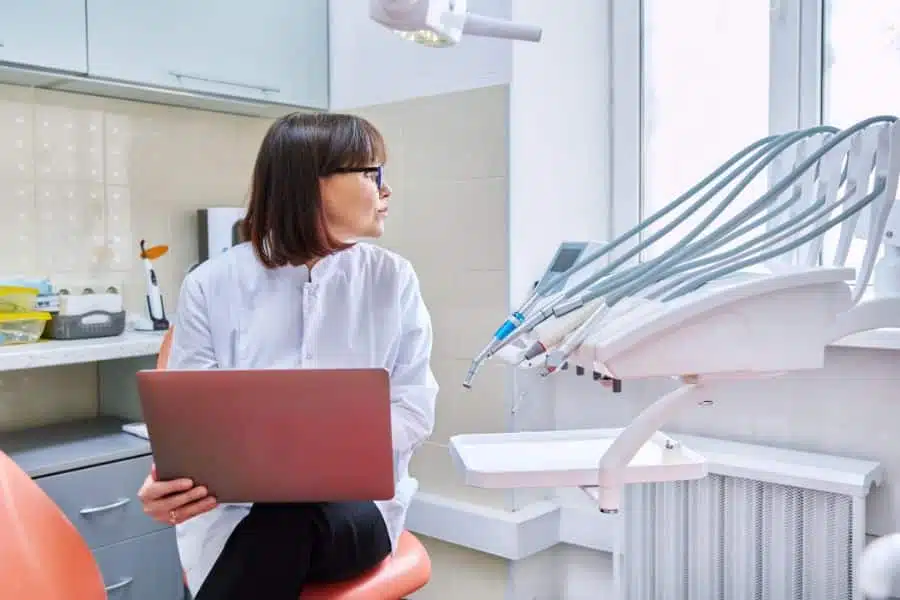
This article is adapted from Medical Advantage’s Article “How to Write the Best Content For Your Medical Website.”
We know that people tend to procrastinate or avoid dental care. So, when a patient is finally ready to get their oral health needs taken care of, it is crucial that your dental practice website has all the information needed to take that next step.
Not every patient will be at the same place in the process. Some will be looking to get a new patient exam, while some will be returning for additional services. For this reason, content for dental websites can be approached from more than one angle, but what we know for sure is that the best dental content online is thoughtful, intuitive, and even empathetic at times.
Writing The Best Content for Your Website
While many variables are at play when coordinating content for your dental website, the main thing to focus on is relevance. Every part of your website, from your “About Us” section to your latest blog, should be about helping patients take that next step in the dental care process.
Some content may fall outside the scope of interest of a patient (like business-related disclosures) but as long as the bulk of the content is intended to help patients make dental care decisions, your website will be right on target.
Take the time to evaluate the content on your website and the purpose that each piece serves. If it is not helping patients or helping the business operations of the practice, it may not belong on the website in the first place.
“Dental website content should be all about helping patients along in their oral care journey.”
How Do I Start Writing Dental Website Content?
Writing dental website content begins with planning. Having a clear purpose for what each piece of content will do helps direct the process. Good website content should be informationally complete overall, but also effective at encouraging the patient to continue in the dental care process.
As they review each page of your website, your patient is getting to know your dental practice, so thoughtful planning should go into how to write content for a dental website. It begins with the core dental web content (what is also referred to as website copy). This covers all the sections of your website, such as your “About Us” section, treatment information, services, testimonials, etc. Ideally, each web page should support your practice’s mission and empower your patients to maintain healthy teeth and gums.
But having all your website pages complete doesn’t mean you are done producing content for the website. Blog content is necessary to build up patient resources while it also helps your dental practice website to be found in search. Google favors well-maintained websites that produce regular blog content.
“A completed dental website does not make the content process complete. To improve your chances of being found in search and to help patients take steps in their dental care journey, your website should have fresh blog content published regularly.”
Provide Relevant Information
While there are digital marketing tools out there that will tell you what search terms are most popular, it helps to study your own patient population to gain perspective.
What dental questions do you hear often? What are your patients’ main concerns about coming in for a routine exam or other procedures? What are their fears? What are some common misconceptions about dental care that you can address? What interesting dental topics can you cover that other dental practice websites don’t address?
Use your patient base as a compass for your dental website content development as you know them best. You might also consider adding a frequently asked questions (FAQ) section for patients who want quick answers rather than poring over blogs. The more you hone in on the information needs and preferences of your patients, the more meaningful your content will be to them.
“What do your patients care about most? Use your patient base as a compass for your dental website content development as you know them best.”
Be Inclusive
You may care for patients who speak other languages or have impairments. Accommodating communication gaps is inclusivity in action. Solutions to consider are:
- Add an ADA-accessibility tool to your website that allows site visitors with impairments to enjoy the content your website has to offer.
- Consider what other languages are commonly spoken within your community. For example, if you see several patients who speak Spanish, having website content in Spanish will accommodate the patient journey for those who do not speak English as their first language.
Avoid Jargon and Other Terms Your Patients May Not Understand
- Yes, you want to have crisp and professional dental website content to maintain credibility in the dental field but writing content for a website that is accessible means writing content that can be easily understood by the average reader. Think about how you would communicate information to the patient over the phone, or in the office. The language used should be natural and easy for the patient to understand.
- If you feel your patients are hungry to learn some of the more complex aspects of the dental world, just be sure to translate terms and jargon that they may be unfamiliar with into plain language. They will be delighted to learn something new from content they can understand.
“Be accommodating! Make sure your website can be used by all – those with language barriers or audio/visual and mobility impairments.
Keep the writing in simple terms patients can understand.”
Keep Language Friendly and Actionable
With a goal to encourage patients to overcome misgivings and make their dental health a priority, content that is compassionate, reassuring, validating, and inspiring does the trick. Many patients who are reading through pages of web content online may be fearful of painful, invasive, and expensive procedures.
Dental website content that shows a deep understanding of what they are going through can help put them at ease, but ideally it should also compel them to take action.
“The most effective dental website will both put a patient at ease and encourage them to take the next step toward oral health and a confident smile.”
Hire Competent Writers and Editors
Most dental practices do not have the time for website content creation for either the core web copy or the ongoing blog production. For that reason, it makes sense to outsource content writing. However, not all website copy or blog writers are prepared to produce content that accurately presents dental information.
It would be a waste of resources if you ended up with content you cannot use on your website, so it pays to ensure that you hire professionals who are up to the task. It is best to work with writers and editors who have a background in dental field writing and know how to write content according to best practices.
Optimizing Your Content for Search Engines
Aside from impressing your audience with expertise, dental website blog content also has a direct impact on how often your practice shows up online. Producing content that is most relevant to your ideal patient often overlaps with natural search terms local dental patients are likely entering into search engines. This is known as search engine optimization (SEO). Google can tell when a website is making a concerted effort to produce quality content on a regular basis to best serve website visitors.
Do Your Research – Keyword Research!
One powerful way to strengthen your online presence is with a thoughtful keyword strategy. There are keyword research tools available to identify the best dental or local keywords for your website. These tools are typically in the hands of marketing specialists who are hired to manage website content.
Dental SEO keyword inclusion is paramount for dental website content. First, the website content should clearly indicate what kind of practice (general dentistry or specialized) it is, what geographic areas it covers, and any particulars regarding the patient population served.
Next, blog content should focus on dental topics relevant to those seeking care, and include popular search terms relevant to the topic so that content has the best chance of showing up on search engines.
Google is constantly scanning the internet and indexing each website for what it contains. This helps it determine which user search terms the content is relevant to. Having quality dental website content that is rich with keywords relevant to patients in your area best positions your dental website to be found online by prospects.
“Google search is powered by content keywords. Be sure to include natural search terms, and words that help Google understand who your website serves.”
Use Internal Linking to Navigate Users Through Your Website
Linking content to other related content (such as site pages, landing pages, and blog articles) helps Google better understand the relevance of each piece. If you can get other websites to link to your content, that is a great help toward building digital authority for your website – driving more traffic to your site.
Linking encourages engagement by providing an information-hungry site visitor more items to consume. Those who read your content will appreciate that you have linked to other content they may be interested in.
Using Good “Technical SEO Hygiene”
Because SEO is an integral part of your content strategy, peripheral website elements also contribute to high-performing websites.
- Alternative-text (Alt-text) for images: What is in your images? Alt-text or descriptions of images help Google better understand the visual content.
- Formatting: Web content follows a formatting standard involving headers and tags.
- Sitemap: Having all your content organized into a sitemap also helps Google get an accurate assessment of your website.
- Document changes: When you have made improvements to your site, you should get credit for it. Submitting updated content to Google for indexing helps Google recognize these key updates.
“SEO terms get very technical and may sound foreign to you, and that is okay. Those experienced in SEO digital marketing can help get everything set up the right way for your dental site to go the distance toward reaching patients online.”
iHealthSpot is Your Go-To for Complete Dental Practice Website Services and Digital Marketing Solutions
Creating a content plan can be difficult to navigate and finding the right people to create content also takes away from dental practice resources, so we’re here to help. Our experienced dental website design specialists will give you that interactive modern website your patients want.
SEO and dental PPC (pay-per-click) services are also performed by our team to ensure that your dental website is not just ready for visitors, but also builds your authority and engages patients. Our goal is to grow your practice by increasing website traffic and attracting the right patients – this all begins with having the best website content. Check out our dental client success story here!




